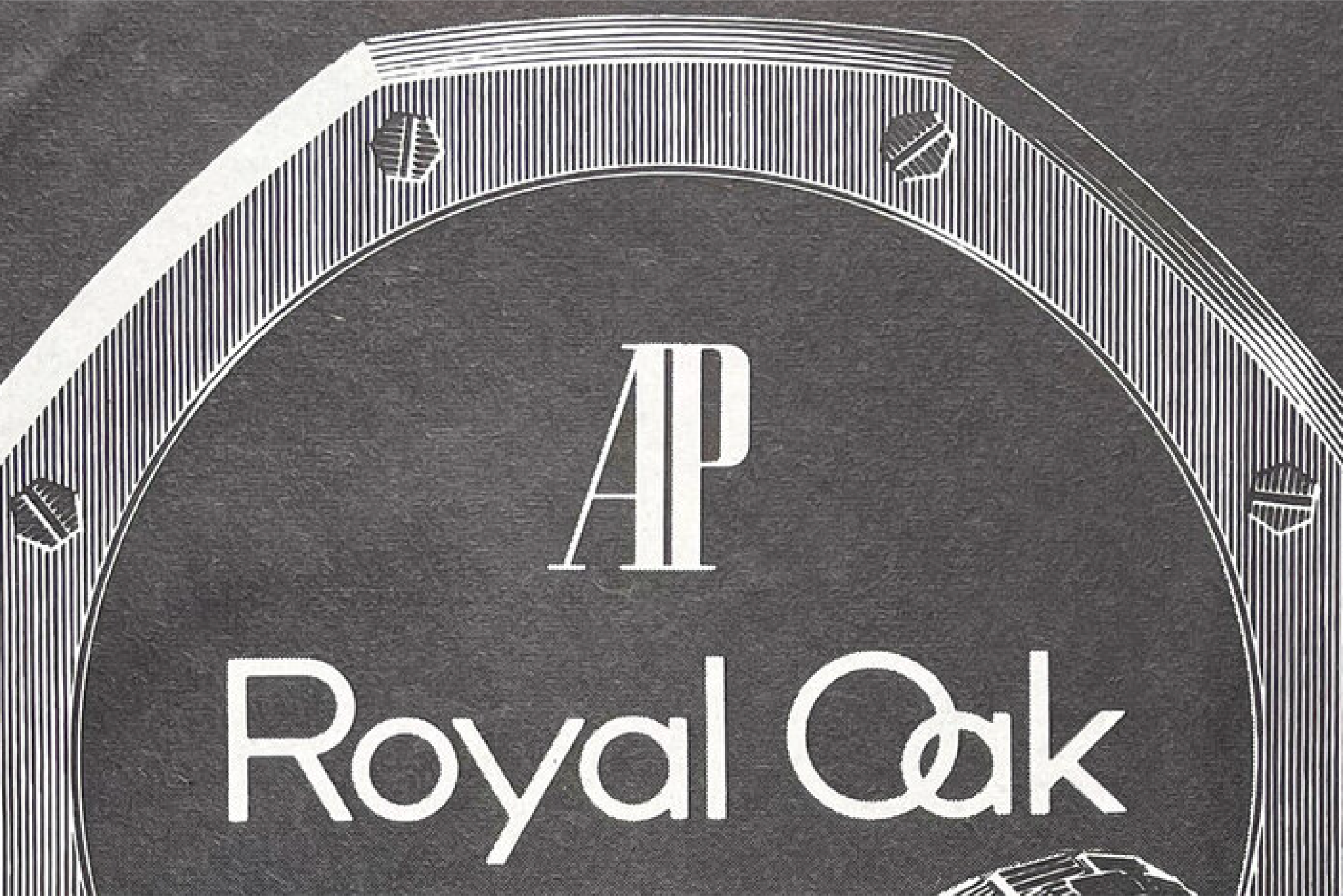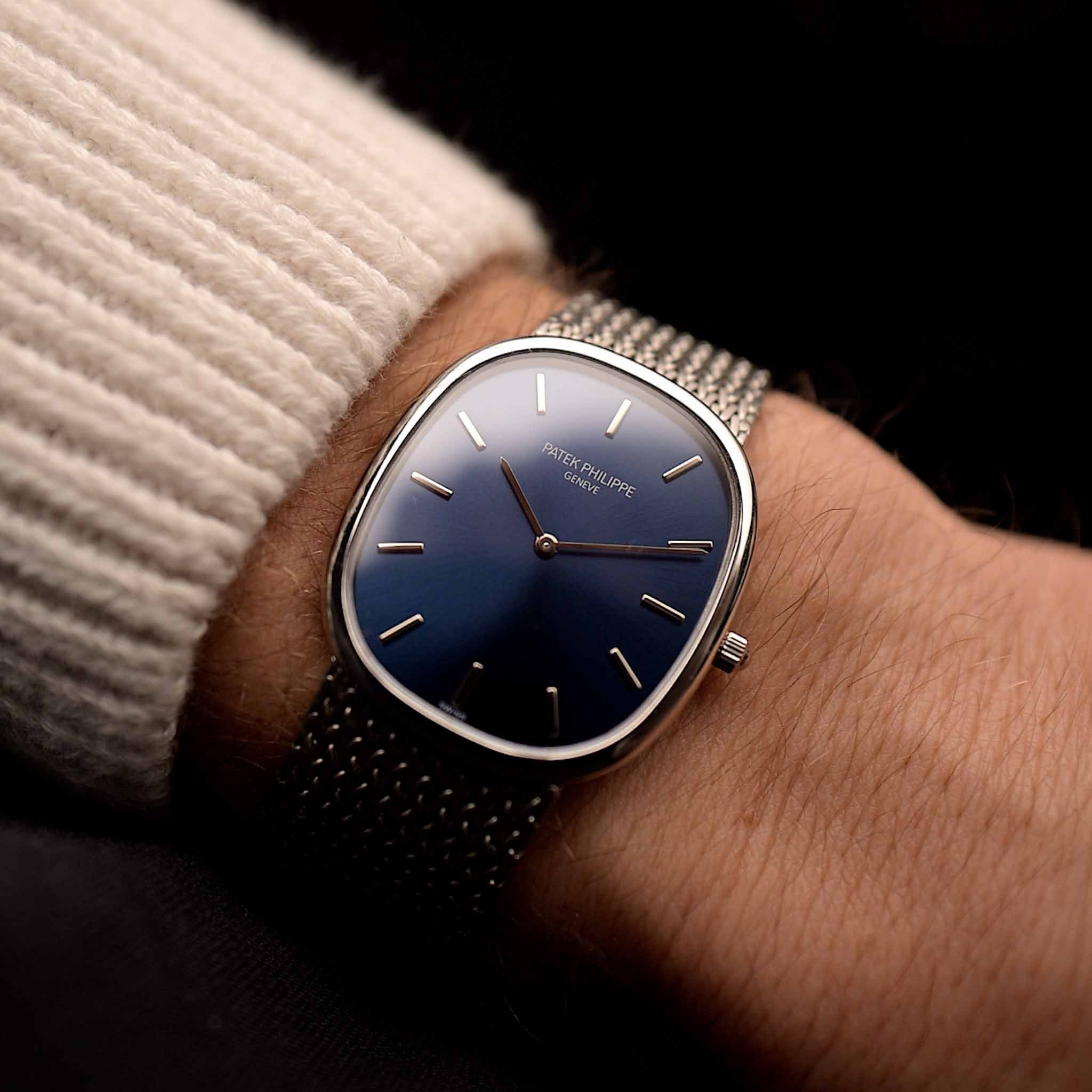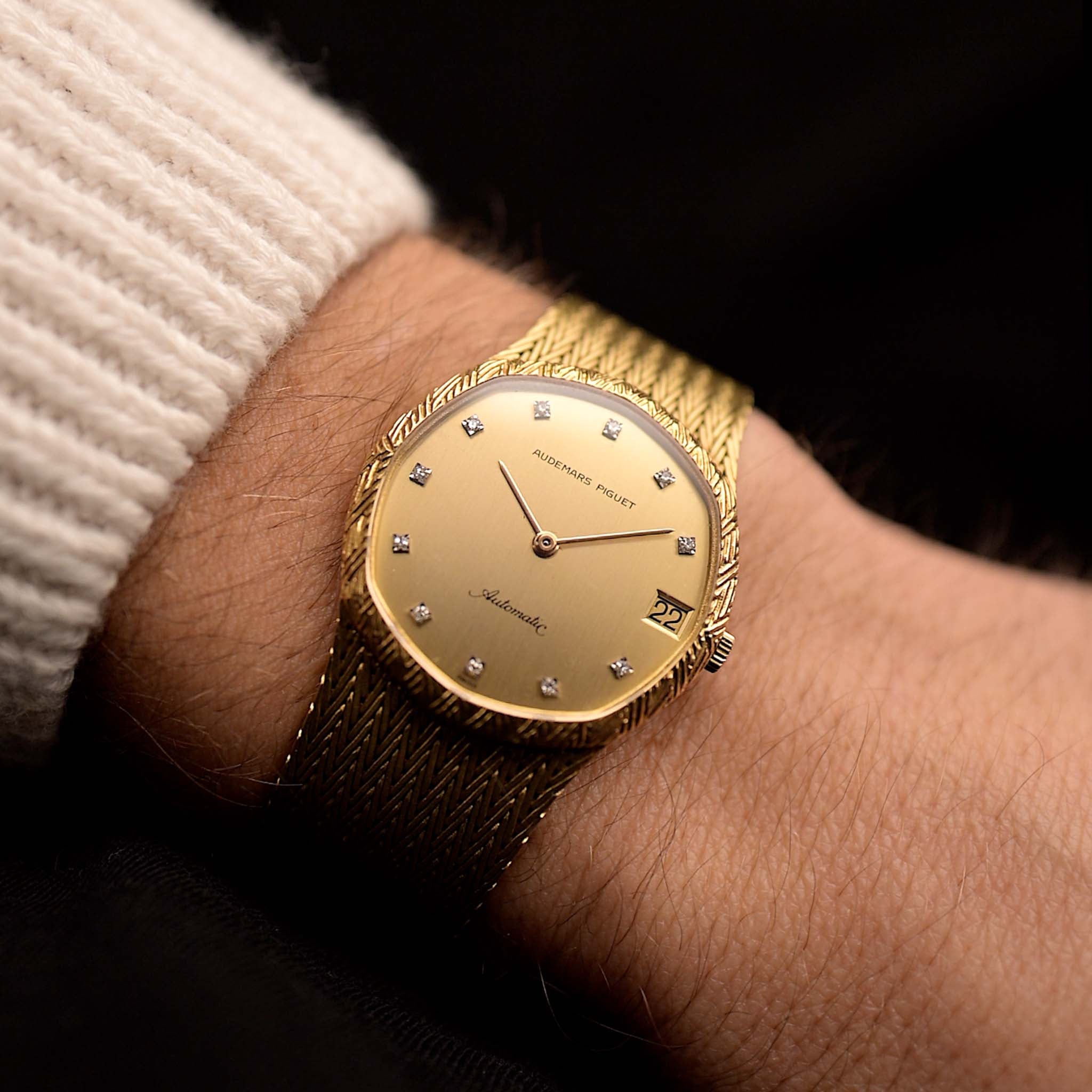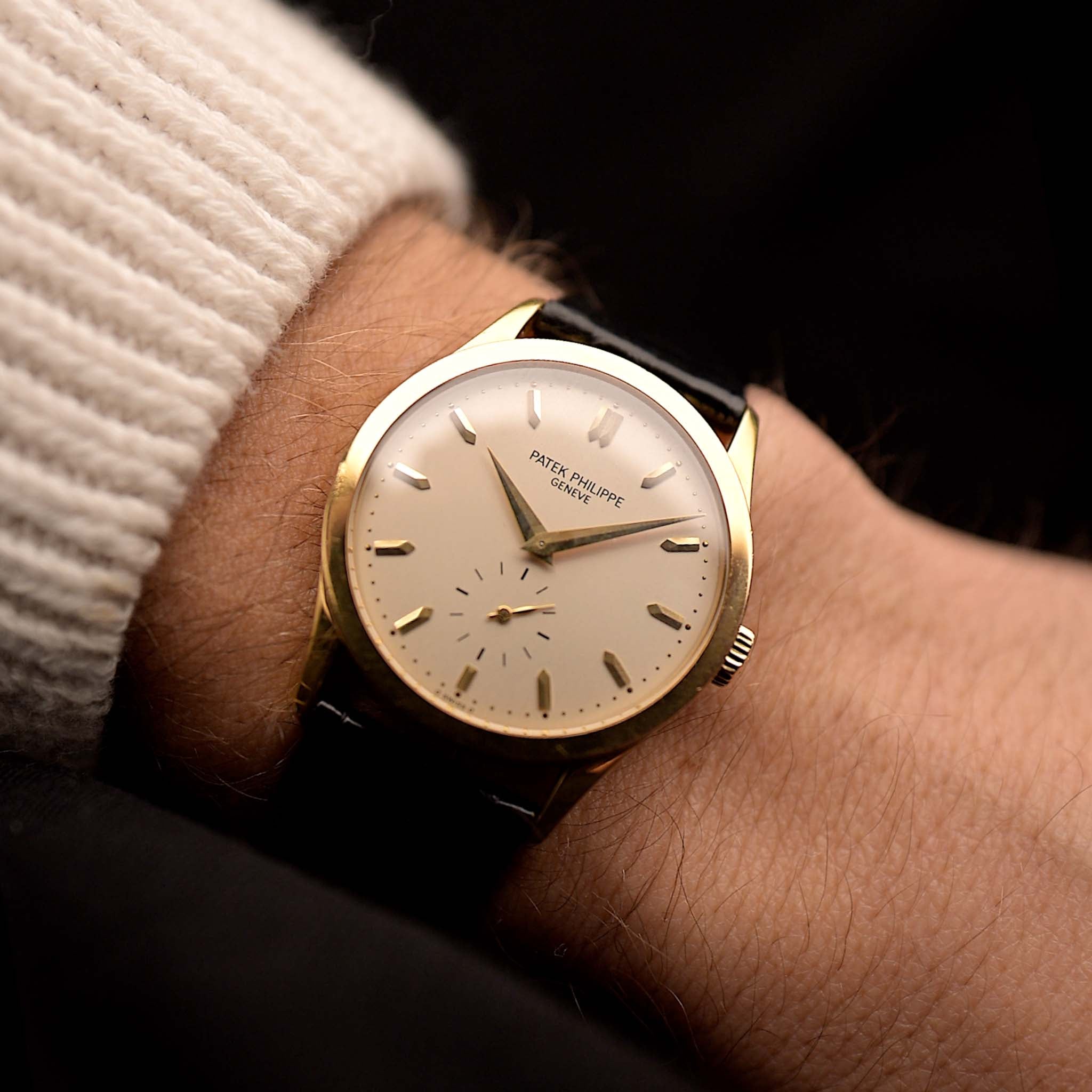A pivotal part of Gerald Gentas legacy of certainly the revolutionary case design of the 5402 Royal Oak. Something the world has not seen before; A high-grade stainless steel luxury sports watch with an integrated bracelet, visible gaskets, bezel screws and last but not least the octagonal case shape itself. So unconventional even Audemars Piguet marketing department picked up on it several times.
December 14, 2021
How the Royal Oaks Bolt Design Went Down in History
 Marcus Siems @siemswatches
Marcus Siems @siemswatches
Collector, Author, Data Analyst
We've seen a lot about this icon by now but the most pivotal and controversial point in the design of the Royal Oak 5402 is definitely the case. Something the world has not seen before; A high-grade stainless steel luxury sports watch with an integrated bracelet, visible gaskets, bezel screws and last but not least the octagonal case shape itself. So unconventional even Audemars Piguet marketing department picked up on it several times[6]. But the story of this case is the story of its designer.
 "You'd think, he taunted, for $5800 they'd have concealed the bolts." - Vintage Audemars Piguet & Gubelin Ad[6].
"You'd think, he taunted, for $5800 they'd have concealed the bolts." - Vintage Audemars Piguet & Gubelin Ad[6].
Interestingly, the very first octagonal watch, a 1917 woman's jewelry watch, was an Audemars Piguet as well[7]. But the Royal Oak made this particular case design its own. A design that other bold rather artsy pieces would later adapt as well. The Bulgari Octo Finissimo as well as the Cartier Santos Octagon clearly give a nod towards the original 5402. Yet, why hasn’t there been more variance in case design prior to Gentas masterpiece?
 Did you know? The very first reported octagonal watch, a 1917 woman's jewelry timepiece, was actually an Audemars Piguet as well[7]. Photo courtesy of Audemars Piguet©.
Did you know? The very first reported octagonal watch, a 1917 woman's jewelry timepiece, was actually an Audemars Piguet as well[7]. Photo courtesy of Audemars Piguet©.
Gerald Genta, the figurehead watch designer of the last century, surprisingly was also one of the first of his craft. In his young years, when Genta was with Universal Geneve throughout the 1950s and early 60s, the position of a “watch designer” didn’t really exist. Rarely did watch manufacturers even have their own design departments. Genta was employed as a watchmaker at first, an engineer[2]. So he worked on the micro-rotor (Microtor), which in turn enabled the Polarouter to be designed.
 The steep incline of the octagonal case shape popularity starting with Gentas original design - the patent seen on the left. Data from Chrono24[1].
The steep incline of the octagonal case shape popularity starting with Gentas original design - the patent seen on the left. Data from Chrono24[1].
But how did the design process then work back in the mid 1950s? Typically a watchmaker or manufacturer would send his ideas to the case maker who in turn designed a selection of cases that the manufacturer could choose from. It was a highly decentralized process that needed a tight-knot relationship between watch- and case maker.
 The divine proportions of the Patek Philippe Golden Ellipse is what enabled a new era of watch-case design. Photo @goldammer.me
The divine proportions of the Patek Philippe Golden Ellipse is what enabled a new era of watch-case design. Photo @goldammer.me
But all of this changed in 1968 with the Patek Philippe Golden Ellipse. A watch that Genta was involved with himself. For the first time Patek developed the case design internally and instructed the case maker (Ateliers Réunis) on how to execute this classic[3,4]. It’s a paradigm shift that for the first time allowed for a centralized design process under one roof. This is the transition towards holistic watchmaking including the entire design process.
In a way the Patek Philippe Golden Ellipse enabled the Audemars Piguet Royal Oak of 1972. The extremely unusual case of the 5402 comes at a time when several manufacturers push the limits of what is possible in terms of case design. The aforementioned Heuer Monaco is another example but the list goes on with the Omega Speedmaster Mark II or the Citizen Bullhead for example. Along with AP themselves who brought to life several asymmetric and off-shaped unisex and women's dress watches in the middle of the last century[7]. Non-circular cases are a thing of the late 60s and 70s. Yes, the Royal Oak is the first very successful octagonal case design but it still follows trends of the time in a sense, a meta-trend if you want.
 Arguably not only the shape but the entire construction of the Royal Oak 5402 has been a novelty. The bolts on the bezel serve the purpose to actually hold the case-construction together - potentially a nod to one of the very first men's wristwatches - the Cartier Santos[5]. As depicted here through the initial patent from Audemars Piguet.
Arguably not only the shape but the entire construction of the Royal Oak 5402 has been a novelty. The bolts on the bezel serve the purpose to actually hold the case-construction together - potentially a nod to one of the very first men's wristwatches - the Cartier Santos[5]. As depicted here through the initial patent from Audemars Piguet.
Nevertheless, the Royal Oak 5402 wouldn’t have been such a success and such an icon if the execution of the design wouldn’t be as striking. The shape is something I can quantify and put into temporal perspective. But the way the case is finished, how screws are incorporated into the bezel, how the bracelet is integrated… these are details that can only underline the legacy of this reference.
This is the Royal Oak. A watch designed with both an eye to detail and a feeling for the big picture. The 5402 defined it’s own watchmaking genre when it was introduced and redefined the value of a material. In the end a watch is a processed and finished product and not the raw metal. But Gerald Genta didn’t stop there with his opus magnum; the dial and the case are designed in sync, representing an abstract vision of a brass helmet that resonates with every detail. It is a timepiece that was so utterly new in 1972 yet included clear trends of its time. Creativity is taking two things that haven't been combined yet and make it work.
 "AP Royal Oak - A tribute to steel". Vintage Ad for the Royal Oak 5402[6].
"AP Royal Oak - A tribute to steel". Vintage Ad for the Royal Oak 5402[6].
But is the initial Royal Oak concept an anachronism? The question remains, into which era would this timepiece fit best? If not 1972 when else? In the next part I want to introduce you to a novel concept: A watches design age representing both its heritage and the influence on the future market. A concept that is based on all the little details of a watch, combined under one statistic. What timepiece would be better suited for a proof of principle than the unique AP Royal Oak 5402?
All about the Royal Oak 5402 here:
Part I - Taking Roots in Modern Horology
Part II - A Trendsetting Dial
Part III - A Creative Dial
Part IV - The Bolt Case Design
Part V - Design Heritage
References
[1] Watches from Chrono24, extracted 2020 Nov. 29th; Karlsruhe, Germany;
[2] Gerald Genta Royal Oak and Nautilus; Franz Rivoira, TheTruthAboutWatches;
https://thetruthaboutwatches.com/2019/12/gerald-genta-royal-oak-and-nautilus/
[3] The History Of The Golden Ellipse; Tania Edwards, Collectability;
https://collectability.com/learn/the-history-of-the-golden-ellipse/
[4] Patek Philippe Golden Ellipse – the first 18k blue gold dial; Felix Goldammer, Goldammer Vintage Watches;
https://www.youtube.com/watch?v=0gXHHeAI5rQ
[5] A Brief History: The Cartier Santos; Revolution, RevolutionWatch;
https://revolutionwatch.com/brief-history-cartier-santos/
[6] Ad Patina - Audemars Piguet; Nick, Ad Patina;
https://www.adpatina.com/audemars-piguet
[7] Stories From La Brassus; Audemars Piguet;
All rights on text and graphics reserved to the Author.



























Leave a comment